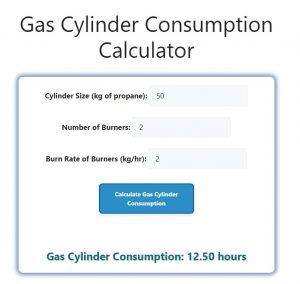About Gas Cylinder Consumption Calculator (Formula)
A gas cylinder consumption calculator helps you estimate how long a gas cylinder will last based on the size of the cylinder and the number of burners used. This tool is essential for households, restaurants, and industrial kitchens that rely on gas for cooking, heating, or other purposes. By calculating the consumption rate, you can plan for refills and avoid running out of gas at inconvenient times.
Formula
The formula for calculating gas cylinder consumption is:
Gas Cylinder Consumption = Cylinder Size / (Number of Burners * Burn Rate of Burners)
Where:
- Cylinder Size refers to the total capacity of the gas cylinder in liters or kilograms.
- Number of Burners is the total number of gas burners being used.
- Burn Rate of Burners is the amount of gas each burner consumes per unit of time (e.g., liters per hour).
How to Use
To use a gas cylinder consumption calculator, follow these steps:
- Determine Cylinder Size: Check the label or documentation of the gas cylinder to find its total capacity in liters or kilograms.
- Count Burners: Determine how many burners or appliances are being used with the gas cylinder.
- Find Burn Rate: Identify the burn rate for each burner, typically listed by the manufacturer (e.g., liters or kilograms per hour).
- Enter Values: Input the cylinder size, number of burners, and burn rate into the calculator.
- Calculate: The calculator will estimate how long the gas cylinder will last based on the given values.
Example
Let’s say you have a gas cylinder with a capacity of 50 liters, and you are using two burners, each with a burn rate of 2 liters per hour. The formula would be applied as follows:
Gas Cylinder Consumption = 50 / (2 * 2) = 50 / 4 = 12.5 hours
This means your gas cylinder will last approximately 12.5 hours under these conditions.

FAQs
- What is a gas cylinder consumption calculator?
It is a tool used to estimate how long a gas cylinder will last based on the number of burners and their consumption rate. - Why is knowing gas cylinder consumption important?
Understanding gas consumption helps ensure you don’t run out of gas unexpectedly and allows for better planning and budgeting. - How do I find the burn rate of a burner?
The burn rate is typically provided by the manufacturer and can usually be found in the appliance’s manual or on its label. - Can I use the calculator for different types of gas?
Yes, the calculator works for various types of gas, such as propane, butane, or LPG, as long as you have the correct values for cylinder size and burn rate. - What is the burn rate of a standard stove burner?
A typical stove burner may have a burn rate of around 1-2 liters or kilograms of gas per hour, but this can vary by model and manufacturer. - How does the number of burners affect gas consumption?
More burners in use will consume more gas, reducing the overall time the cylinder will last. - How do I know when to refill my gas cylinder?
Using a consumption calculator can help you estimate when the cylinder will be empty, so you can plan refills in advance. - Can this calculator be used for industrial gas systems?
Yes, it can be used for both residential and industrial systems, as long as you input the correct values for cylinder size and burn rate. - What happens if I use a high-output burner?
A high-output burner will have a higher burn rate, which means the gas cylinder will be consumed faster. - Can I calculate gas consumption for a single burner?
Yes, simply set the number of burners to 1 in the formula, and you can calculate consumption for just one burner. - Does the size of the gas cylinder matter?
Yes, the larger the cylinder, the longer it will last, as more gas is available for consumption. - Is the calculator accurate for commercial kitchens?
Yes, the calculator can be used for commercial kitchens if accurate values for burner count and burn rates are used. - Can the burn rate of a burner change?
The burn rate is generally consistent but could vary slightly based on factors like gas pressure or maintenance of the burner. - What unit of measurement should I use for the cylinder size?
The cylinder size can be entered in liters or kilograms, depending on how the gas is measured in your region. - Can I use the calculator for gas heaters or ovens?
Yes, this calculator can be used for any gas-powered appliance, including heaters, ovens, or grills. - Do I need to adjust the formula for different types of gas?
No, the formula remains the same, but you will need to use the correct burn rate for the specific type of gas and appliance. - How can I reduce gas consumption?
You can reduce gas consumption by using fewer burners, lowering the heat settings, or using more efficient burners. - How does altitude affect gas consumption?
At higher altitudes, gas appliances may have lower efficiency, which could impact the burn rate and overall consumption. - Can gas leakage affect consumption estimates?
Yes, undetected gas leaks can lead to higher consumption than estimated, so regular maintenance is essential. - How often should I check gas consumption?
It’s a good idea to periodically check your gas consumption, especially if you notice that cylinders are running out faster than expected.
Conclusion
A gas cylinder consumption calculator is a useful tool for anyone who uses gas for cooking, heating, or other purposes. By understanding how to calculate gas consumption, you can better manage your gas supply and avoid unexpected shortages. Whether for household use or commercial kitchens, this calculator provides valuable insights into how long your gas cylinder will last based on usage patterns.